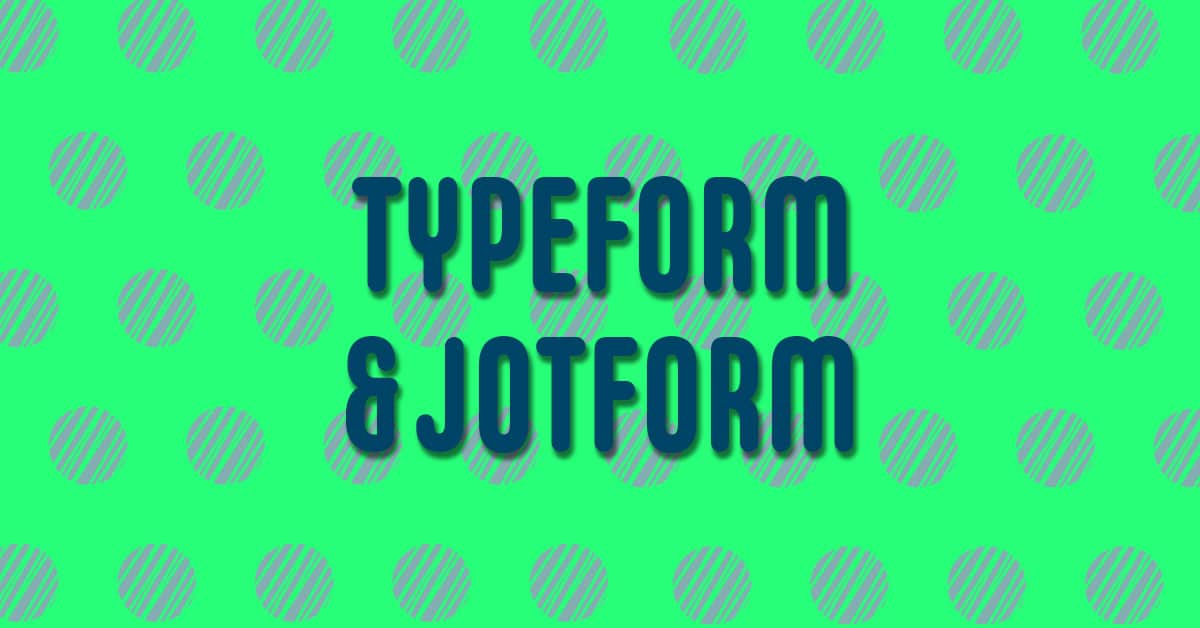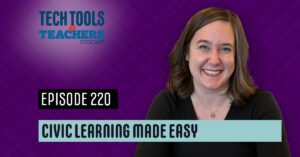Shanna Martin 0:19
Thanks for listening to the Tech Tools for Teachers Podcast, where each week we talk about a free piece of technology that you can use in your classroom. I’m your host, Shanna Martin. I’m a middle school teacher Technology and Instructional Coach for my district.
Fuzz Martin 0:32
And I’m her producer and husband Fuzz Martin and you may not know this, but we formed a relationship because she decided I was her type and then jotted down my number.
Shanna Martin 0:44
Good job. That’s a good one.
Fuzz Martin 0:45
Thank you. Okay, real quick.
Shanna Martin 0:49
Nice. Nice work.
Fuzz Martin 0:50
Thank you. Thank you so much.
Shanna Martin 0:53
Not that anybody else knows what you’re talking about? Yeah, very good.
Fuzz Martin 0:56
I mean, if they read the episode title, that’s true.
Shanna Martin 0:58
They may understand your cleverness today. Yeah. So here we are. marching through
Fuzz Martin 1:05
November, marching through November.
Shanna Martin 1:07
How is it already? November? I don’t know. But I’m still in August. Yeah.
Fuzz Martin 1:12
Well, guess what?
Shanna Martin 1:13
You gotta whether it’s not but I gotta catch up. I’ve been so busy. Yeah.
Fuzz Martin 1:19
They’re all over the place. And now we’re back.
Shanna Martin 1:22
I mean, with a brand new adventure, you listening?
Fuzz Martin 1:24
It doesn’t sound like we’re gone. Because technology.
Shanna Martin 1:29
Over here, yeah, we are quarter two like, order like, it is the second quarter. My elementary teachers work on trimesters. So there’s still finishing up trimester one, parent teacher conferences are rockin so many things are happening on Yeah, that’s like, we have two tools that we haven’t discussed. They’re like rival, they are, but they work. They will win. But they work similarly. And depending on the needs of your students or classroom, you can kind of figure out which best free version works for you. Because they each have a paid version. And they each have a free version, but their free version are slightly different. So depending on what you’re going to use it for, or your students are going to use it for, then you can make the choice, but they work pretty similar. We are talking about type form and jot form today. Okay. And so a couple weeks ago, my students started cranking out projects, this product, my classroom, my students do a lot of inquiry projects. And they come up with different ways of sharing their knowledge with their classmates. And I give them a variety of things to pick from. And one of my students like me to do a digital game, but I don’t want to do Kahoot, I don’t want to do look at I don’t want to do like no other all the things that everybody else does. And he wanted to be different. And I was like, that’s cool. So we googled it, because that’s the thing to do. Anyway. So we came across Typeform, which is a really cool site. So it offers is like free options. And it has lots of paid options. But basically type form if you wanted to, like jazz up Google Forms and make them way cooler and more fun. That’s what Typeform is. So there are like pre created templates if you choose to, or you can go into the land of starting from scratch, you know, designing, I can choose. And so you can start from scratch, you can use a template, you can have them created for you, which I won’t let my students and so they can pick a topic or a format. So we’re doing quizzing, like there’s other. There’s lots of other types of formats you can pick from. And so when you go to create a Typeform, let’s say you want to use a template, there’s like feedback forms and research forms and registration forms and application forms and polls and giveaways and requests. So there’s a lot of different ways you can use this. I’m using it as students sharing out information from a project. But if you are teaching a business class, like go for if you’re teaching any sort of government class where they’re polling for information or argument writing, like they can use the polls. Like registration, like teaching them how to just different skill sets, applications skill set, you know, there’s just so many ways you can use this and other sites besides just creating quizzes, but that’s what we happen to use it for.
Shanna Martin 4:41
So that’s my example that I’m talking about. But there’s a lot of options that you can do. So, to create a quiz though, you can pick a template. There’s literally a math quiz template for anybody that wants to test out just to play around with it. And it’s super cool. It gives you the questions when you were From the template, it gives you the I love the What’s your name? Because then it drops the person’s name into every question. Oh, so that it feels personalized, even though it’s not, right. And you can do that with a Google like. In Google Sheets, you can play around with like, where things like, drop from each sheet to sheet, you can do some stuff like that. But it’s not like type it in there it goes shows up for you never that, you know, like, this is very, the formulas done for you.
Shanna Martin 5:29
So it’s just cool looking. So they had the name thing in there. So everyone felt like, oh, what’s my name? And I asked the questions. And then the questions are there, it gives you the little bubbles to put the answers in. And so you can just work your way through the template, changing the questions, keeping the questions, it gives you multiple choice at, you know, answers, you could add choices in there if you choose to. And you can change the settings in there. So you can make them required, you can give them multiple selections. You can give different alignments, you can add video, you can add images. And then two, you can choose if you want it to slide from one question to the next questions, you answer it in automatic flick scrolls up to the next one.
Shanna Martin 6:16
Yeah, you don’t have to do a new page, or it just kind of it makes it like a cool little interactive thing. So it’s a way of making a form interactive and more like visually appealing. Way more engaging them on a Google Form. Yes, you feel like you’re like, hey, Shanna, like, are you ready to answer questions today? All right, just one great like, you just feel different. So when my students are doing a project, it feels like there’s more to it than just putting a Google form. And I think kids use Google Forms and crank out some amazing escape rooms. Like there’s a time and place for sure, sure. But to make a cool looking interactive kind of game that’s not like all the others. They were making quizzes here on type form. Sure.
Shanna Martin 7:01
And there’s a gallery of sticking to like questions. And sorry, gallery questions, I’m distracted, I’m design, you can go into them. So you can have like your brand kit if you don’t want to upgrade of the fancy plan. But you can choose colors and backgrounds and things like that. Some adjustments, not as many when you’re not using the like when you’re using the free version. But you can choose like, I want everything in shades of green, right? I want everything in shades of orange and yellow, like you have options. I want shades in blue with cool, like graphic designs in the background. Oh, wait, that’s the more expensive one. So you can pick and choose from the free version of what colors you want, which is kind of fun. But anyway, so this just felt a lot more engaging. And then also, if you are working on like the right hand side of the screen, they give you this logic portion where it shows you like this question can go this way or this way. And then how do you like? Like, how do you visually see the layout of everything right, which I appreciate.
Fuzz Martin 8:04
The other cool thing like you could do with that logic is create like you could have students create a choose your own adventure story. So with the logic, if they select one choice, it goes to one next question.
Shanna Martin 8:16
And it’s almost like a digital escape room. Yeah, exactly. Choose your own adventure. Absolutely. Yep. Yeah, I like that.
Fuzz Martin 8:22
So yeah, and they also allow for things like ranking and an opinion scale in the free version. So if you want, you know, like, rank these top things, and you can slide stuff around. And it’s pretty cool.
Shanna Martin 8:36
Yeah. So there’s a lot of there’s a lot of options. And it’s just kind of a nice way for kids to be able to create another way of looking at something, to share their information out with others. Now, I will say in the setting that we were using it in the only. So in the free version of Typeform, you can have like 10 responses, you could have as many you can create as many of these as you want to. But you only can have 10 responses, like locked in at the end. Yeah. But how we were doing it is the student was having, like, projecting it. And then you can just have, like everybody, like as a group, like decide what the response is going to be sure. So then it wasn’t we didn’t, it didn’t matter to us that we weren’t all responding individually, because we were just responding as a class. Yeah. So that’s just something to be aware of like it wouldn’t, you wouldn’t necessarily want like to send this out to your students on the free version, because you would only get 10 responses. So that’s something to be aware of how the free version of this works, yes, for this one, or this one. That’s why we’re pointing this out. So for Typeform there’s lots of cool options with it, but you probably would want to do a whole class response kind of deal or small group response deal. Instead of having individual responses right.
Fuzz Martin 9:53
So Typeform unlimited forms,
Shanna Martin 9:56
Correct, but only 10 responses.
Fuzz Martin 9:59
Ah And then Jotform that
Shanna Martin 10:01
form. So let’s jump to the competitor and tell you the highlights there. So they also have lots of templates to choose from. I appreciate to their template formats are a little bit different. So you can do feedback. Like information requests, I thought was kind of cool that it was like a product order form is would it be so cool, if you’re having a students do a mock business, to do it create their own online store, I’ll show you how to set that up. Because like, you taught me a lot about setting stuff like that up. Yeah. And that would be a way to like practice, like, those are skills that people need, right? Especially if we’re going into business nowadays. But anyway, so there’s order forms. So you pick a template, whatever you choose, as you was leaving a table reservations, um, nice. And so we’re in for spring booking forms, RSVP forms, signup forms, voting forms, polls, all kinds of stuff, bigger form, whatever you want to do a kajillion templates, again, like a template. Now, if I want to use a template in jot form, it will come up similarly, where you can build and have settings and, and add logos and change font, it’s the setups a little bit different. But you could add different content, you can change your settings, your thank you page, like different things like that. If you go to publish, it does share the same, they both have the copy link to be able to share, and then other things like social media QR codes, but you can still you can copy a link and share it. So the free version of chat form is gonna be slightly different. So while you have all like the designer template, the things that you get five forms a month, but you can have 100 submission.
Fuzz Martin 11:54
Yeah, five total forms, and you get 100 monthly submissions. So that way,
Shanna Martin 11:58
so if you wanted a whole class to fill in a form or you wanted, like some, like more interaction, you could do that.
Fuzz Martin 12:04
But like, if you think about it, so in this case, kids could create their form and have everybody in the class, fill it in, right, but they’re likely not going to create more than one form for that project. So that’s something
Shanna Martin 12:17
projects type work, like if you’re gonna do forms, like Google Forms is always the way to go. Just because you’re collecting information, like as a teacher, I’m thinking though, a kid, having some real world project like real world project application experience, yeah, where they’re using templates that you would not do in Google, and then share out information that way, right, or design, you know, a business plan, or, like, for me, they’re sharing out information about Wisconsin, you know, so it’s, it’s different. I’m using it in a project format. So that’s what I’m thinking. So depending on what you want your kids to do. So if they just want to create the form and do it as a whole class, I would use type form. But if they’re going to do a form and create something cool and want the whole class to participate, that I’m gonna Jotform, and those would be the difference. Yeah, I would almost think to formatting is different. I will say that they’re not like lightyears away from each other, but there are differences. So you would definitely want students to kind of look through and see what would work best for their use of information. Yeah,
Fuzz Martin 13:19
Typeform, I think is prettier in most cases. And like, in the way that it works, though. JotForm has more templates. So Correct. Yeah. And, yeah, but they’re, they’re both very cool.
Shanna Martin 13:31
They both teach a lot of to me, like some life skills stuff along with sharing information for projects for school. Yeah, there’s a lot more definitely middle school, high school. Oh, yeah. For just ease of understanding how they work.
Fuzz Martin 13:45
And I wouldn’t say JotForm is more of that, like, web building type of, I’d say, type forms more like presentation style. Yep. Jot form is more like web building with that’s the one that has the product pages. And you can actually even create apps. And there’s a whole bunch of other templates that they have table templates and PDF template. Yeah. So those kinds of things that are that are not in type form. But so again, play with them both you can get, you could do it for free. So get them there and play around yourself and see what would work best in your
Shanna Martin 14:17
class. Yep. Or give it to a kid because you don’t necessarily have time. And there are kids that love to play around with things and then report out on what they discover. There you go. So there’s that too. But yeah, so Typeform, Jotform, creating cool forms for projects with students sharing information two different ways. Just because depending on what you want to use it for the free versions can benefit you in two different ways. Yeah, there you go. So thanks for tuning in.
Shanna Martin 14:44
This has been the Tech Tools for Teachers podcast. If you ever have any questions, you can find me on Twitter @smartinwi. And if you want to get more information the links to the technology discussed in this episode isn’t smartinwi.com or find me on Facebook. If you’d like to support the show Please consider buying me a coffee or to visit buy me a coffee.com/smartinwi and or visit smartinwi.com and click the cute little purple coffee cup for your donations help keep this show going. New episodes each week. Thanks for listening, go educate and innovate.
Fuzz Martin 15:18
The ideas and opinions expressed on this podcast and the smartinwi.com website are those of the author Shanna Martin and of her employer. Prior to using any of the technologies discussed on this podcast? Please consult with your employer regulations. This podcast offers no guarantee that these tools will work for you as described, but we sure hope they do.











